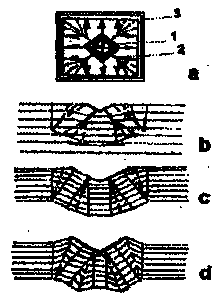
MICROSTRUCTURE AND TEXTURE OF DEFORMED ZONE BY INDENTATION. D.Z.Grabko, M.I.Medinskaya, Yu.G.Saltanovsky Institute of Applied Physics, Academy of Sciences, Kishinev, Moldova
The microstructure of hardness indentation surface and texture of the deformed zone under it were investigated on (001) plane of KCl, NaCl, NaF, LiF, MgO single crystals. The loads on the Vickers pyramide P = 0.02 -2 N. Deformation temperature interval Tdef = 77/800 K. At low Tdef < 0.3Tmelt the characteristic .a,l). Their origin as well as cracks along < cracks on indentation surface were revealed (Figure110> direction outside the indentation have dislocation nature. P growth led to the increase of cracks number. The cracks number decreased with Tdef growth and the displacement steps appeared instead of them. On the whole their arrangement repeated the indentation orientation. It signifies that frail destruction and plastic displacement take place during indentor depending into the crystal an arise as a result of very high inside stresses. Cracks along <110> and sliding strips around indentation (Figure a, 2,3) also have relaxation nature. But their appearance is connected with stress relaxation after indentor removal.
Texture of deformed zone under indentation also testifies of unhomogeneous flow of plastic deformation (Figure.b-d). The investigated crystals can be divided as to their texture shape into two types: soft and hard ones. In dependence of the Tdef, one and the same crystal shows properties of either hard (Tdef>0.3Tmelt) or soft (Tdef >0.3Tmelt) crystals. A peculiar pressing figure, the destruction zone (Figure.b-d)and in detail investigated dislocation zone. The dimension of this destruction zone is D~2/3 dind.The most complicated dislocation reactions, leading to the material translation, rotary processes,structure fragmentation etc., take place in this region by indentation.
